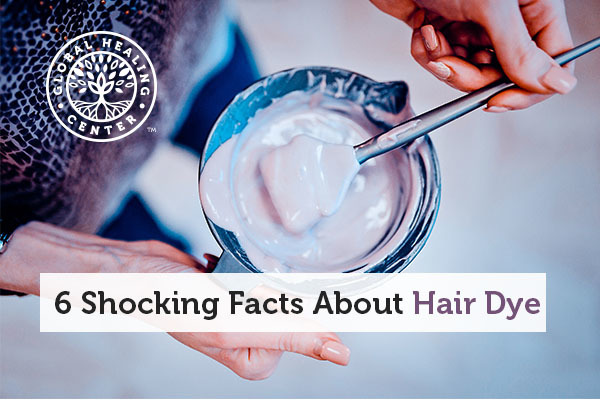
Many women and men see their hair as an important aspect of their physical appearance – a fact deeply reflected in hair dye’s continued popularity. People of all ages use hair dye to enhance their physical appearance and change the way they view themselves. While this isn't inherently a bad thing, the more we learn about chemical-based hair dyes, the more we realize that exposing our bodies to these toxins is counterproductive to living a healthy life. Here are 6 absolutely shocking facts about hair dyes that'll make you go natural.
Hair Dye Facts You Should Know
1. Hair Dye Contains Over 5,000 Chemicals
Hair dye is a solution filled with a multitude of chemicals, some of which are potent carcinogens. While it may seem like a "freebie" since you're not really ingesting them, the fact that hair dye sits on your scalp and is absorbed by your skin is still a reasonable cause for worry. Not to mention breathing in the chemical fumes pose just as much threat as absorbing them. [1]
2. Linked to Rheumatoid Arthritis
Rheumatoid arthritis is crippling and disfiguring, and no one wants to go through the pain associated with it. It turns out that certain factors can increase one’s risk of developing rheumatoid arthritis, and chronic exposure to hair coloring is one such factor. Before you dye your hair, keep in mind that a relationship between regular use of hair dye and rheumatoid arthritis has been established. [2] The chemicals aren't prejudiced against age or gender and nobody of any age should use this stuff.
3. Hair Color Can Discolor Your Skin or Kill You
It probably won't kill you, but it can cause methemoglobinemia, a discoloration of the skin – usually blue or gray – caused by lack of oxygen and exposure to paraphenylenediamine, a common chemical found in hair coloring products. Methemoglobinemia can be extremely dangerous and, in some circumstances, even cause death. [3] [4]
4. Dark Colors are the Most Risky
It would seem that dyes with bleach would be the harshest and most dangerous but the exact opposite is true! Dark colors are the most dangerous and the concern is lead. Lead is nasty stuff, yet it's ubiquitous in dark hair dyes in the form of lead acetate, the active ingredient responsible for the coloring effect. [5]
5. Increases Cancer Risk in Infants
Infants don't dye their hair... but sometimes pregnant women do. If there is one time in life when avoiding hair dyes is crucially important, it's during pregnancy. Research has established a link between using hair dye during pregnancy and leukemia in babies. [6]
6. Elevates Cancer Risk for Adults
Chemical exposure of any kind can increase your risk of cancer, especially if the chemicals are known carcinogens, and many of the chemicals in hair coloring products are carcinogens. Hair dye has been directly associated with bladder cancer and has also been associated with lymphoma, a cancer of the lymph system. [7] [8]
Naturally, we all want to look our best; but, before you slather chemicals over your scalp, give it a second thought. Remember, beauty is more substantial than the color of your hair. True beauty comes from one source – glowing health – not a package of dye.
References (8)
- National Cancer Institute. Hair Dyes and Cancer Risk. NCI Fact Sheet.
- Reckner Olsson A, Skogh T, Wingren G. Comorbidity and lifestyle, reproductive factors, and environmental exposures associated with rheumatoid arthritis. Annals of the Rheumatic Diseases. October 2001. doi: 10.1136/ard.60.10.934.
- Ryoo S, Sohn C, Kim W, Lim K. A case of severe methemoglobinemia caused by hair dye poisoning. Human & Experimental Toxicology. March 20, 2013. PMID: 23515496.
- MedlinePlus. Methemoglobinemia. MedlinePlus Fact Sheet.
- FDA. Hair Dye Products. FDA Fact Sheet.
- Couto AC, Ferreira JD, Rosa AC, Pombo-de-Oliveira MS, Koifman S. Pregnancy, maternal exposure to hair dyes and hair straightening cosmetics, and early age leukemia. Chem Biol Interact. 2013 Sep 5;205(1):46-52. doi: 10.1016/j.cbi.2013.05.012.
- Ferris J, Berbel O, Alonso-López J, Garcia J, Ortega, JA. Environmental non- occupational risk factors associated with bladder cancer. Actas Urologicas Espanolas. April 22, 2013. doi: 10.1016/j.acuro.2013.02.004.
- Ambinder AJ, Shenoy PJ, Malik N, Maggioncalda A, Nastoupi LJ, Flowers CR. Exploring risks factors for follicular lymphoma. Advances in Hematology. September 18, 2012. doi: 10.1155/2012/626035.
†Results may vary. Information and statements made are for education purposes and are not intended to replace the advice of your doctor. If you have a severe medical condition or health concern, see your physician.







